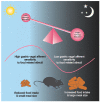Gastrointestinal Vagal Afferents and Food Intake: Relevance of Circadian Rhythms
- PMID: 33807524
- PMCID: PMC7998414
- DOI: 10.3390/nu13030844
Gastrointestinal Vagal Afferents and Food Intake: Relevance of Circadian Rhythms
Abstract
Gastrointestinal vagal afferents (VAs) play an important role in food intake regulation, providing the brain with information on the amount and nutrient composition of a meal. This is processed, eventually leading to meal termination. The response of gastric VAs, to food-related stimuli, is under circadian control and fluctuates depending on the time of day. These rhythms are highly correlated with meal size, with a nadir in VA sensitivity and increase in meal size during the dark phase and a peak in sensitivity and decrease in meal size during the light phase in mice. These rhythms are disrupted in diet-induced obesity and simulated shift work conditions and associated with disrupted food intake patterns. In diet-induced obesity the dampened responses during the light phase are not simply reversed by reverting back to a normal diet. However, time restricted feeding prevents loss of diurnal rhythms in VA signalling in high fat diet-fed mice and, therefore, provides a potential strategy to reset diurnal rhythms in VA signalling to a pre-obese phenotype. This review discusses the role of the circadian system in the regulation of gastrointestinal VA signals and the impact of factors, such as diet-induced obesity and shift work, on these rhythms.
Keywords: circadian; food intake; gastrointestinal tract; vagal afferents.
Conflict of interest statement
The author declares no conflict of interest. The NHMRC had no input in the content or the decision to write this review.
Figures



Similar articles
-
Time-Restricted Feeding Prevents Ablation of Diurnal Rhythms in Gastric Vagal Afferent Mechanosensitivity Observed in High-Fat Diet-Induced Obese Mice.J Neurosci. 2018 May 30;38(22):5088-5095. doi: 10.1523/JNEUROSCI.0052-18.2018. Epub 2018 May 14. J Neurosci. 2018. PMID: 29760179 Free PMC article.
-
High-Fat Diet-Induced Obesity Ablates Gastric Vagal Afferent Circadian Rhythms.J Neurosci. 2016 Mar 16;36(11):3199-207. doi: 10.1523/JNEUROSCI.2710-15.2016. J Neurosci. 2016. PMID: 26985030 Free PMC article.
-
Disruption of the light cycle ablates diurnal rhythms in gastric vagal afferent mechanosensitivity.Neurogastroenterol Motil. 2019 Dec;31(12):e13711. doi: 10.1111/nmo.13711. Epub 2019 Sep 11. Neurogastroenterol Motil. 2019. PMID: 31509314
-
The role of gastrointestinal vagal afferents in the control of food intake: current prospects.Nutrition. 2000 Oct;16(10):866-73. doi: 10.1016/s0899-9007(00)00464-0. Nutrition. 2000. PMID: 11054591 Review.
-
Plasticity of gastrointestinal vagal afferents in terms of feeding-related physiology and pathophysiology.J Physiol. 2024 Oct;602(19):4763-4776. doi: 10.1113/JP284075. Epub 2023 Sep 22. J Physiol. 2024. PMID: 37737742 Review.
Cited by
-
Regulation of Circadian Genes Nr1d1 and Nr1d2 in Sex-Different Manners during Liver Aging.Int J Mol Sci. 2022 Sep 2;23(17):10032. doi: 10.3390/ijms231710032. Int J Mol Sci. 2022. PMID: 36077427 Free PMC article.
-
Circadian rhythms in colonic function.Front Physiol. 2023 Aug 30;14:1239278. doi: 10.3389/fphys.2023.1239278. eCollection 2023. Front Physiol. 2023. PMID: 37711458 Free PMC article. Review.
-
GPR-160 Receptor Signaling in the Dorsal Vagal Complex of Male Rats Modulates Meal Microstructure and CART-Mediated Hypophagia.Nutrients. 2023 May 11;15(10):2268. doi: 10.3390/nu15102268. Nutrients. 2023. PMID: 37242151 Free PMC article.
-
Fasting as an Adjuvant Therapy for Cancer: Mechanism of Action and Clinical Practice.Biomolecules. 2024 Nov 12;14(11):1437. doi: 10.3390/biom14111437. Biomolecules. 2024. PMID: 39595613 Free PMC article. Review.
-
Enteric VIP-producing neurons maintain gut microbiota homeostasis through regulating epithelium fucosylation.Cell Host Microbe. 2022 Oct 12;30(10):1417-1434.e8. doi: 10.1016/j.chom.2022.09.001. Epub 2022 Sep 22. Cell Host Microbe. 2022. PMID: 36150396 Free PMC article.
References
-
- Ma M.A., Morrison E.H. StatPearls. StatPearls Publishing; Treasure Island, FL, USA: 2019. Neuroanatomy, Nucleus Suprachiasmatic. - PubMed
Publication types
MeSH terms
Grants and funding
LinkOut - more resources
Full Text Sources
Other Literature Sources

